ENHANCING COMPUTATIONAL THINKING SKILLS AND TECHNOLOGICAL SELF-EFFICACY OF 4TH GRADE STUDENTS THROUGH PRACTICE ACTIVITIES FOR CREATING ANIMATED STORY ON SCRATCH USING PEER ASSISTED LEARNING STRATEGY
Main Article Content
Abstract
The purposes of this study were to 1) develop an effective practice activities for creating animated story on Scratch using peer assisted learning strategy, 2) investigate an effect of instruction using practice activities on computational thinking skills and technological self-efficacy, and 3) explore students’ satisfaction toward instruction using that practice activities. Samples consisted of 41 fourth grade students, which were divided by cluster sampling technique into 2 groups: an experimental group that learned through developed practice activities, and a comparison group that used the conventional teaching method, comprised of 20 and 21 students respectively. Both groups were assessed a pre-test and post-test, and studied involving the Scratch programming for 8 weeks, two hours a week. Research instruments were practice activities for creating animated story on Scratch using peer-assisted learning strategy, Scratch learning achievement test, computational thinking skill test, technological self-efficacy questionnaire, and satisfaction questionnaire toward instruction using developed practice activities. The data were analyzed using Mean, Standard Deviation, Wilcoxon Match-Pairs Signed Rank Test, and Mann-Whitney U Test. The findings revealed that practice activities showed an efficiency ratio of 1.46, met the Meguigans criterion, with effectiveness index of .8148. Posttest scores of computational thinking skills and technological self-efficacy of experimental group were statistical significantly higher than pretest scores at .01 and .05 level, respectively, and had more improvement than those of comparison group at .01 significant level. In addition, the overall satisfaction of experimental group students was found at a high level.
Article Details

This work is licensed under a Creative Commons Attribution-NonCommercial-NoDerivatives 4.0 International License.
The owner of the article does not copy or violate any of its copyright. If any copyright infringement occurs or prosecution, in any case, the Editorial Board is not involved in all the rights to the owner of the article to be performed.
References
Ackerman, C. E. (2020). What is self-efficacy theory in psychology. Retrieved November 15, 2020, from https://positivepsychology.com/self-efficacy/
Ado Oda, A. (2010). The effectiveness of computer-based learning on developing the 4th graders’English language achievement in Gaza UNRWA School (Master thesis). Gaza, Al-Azhar University.
Barr, V., & Guzdial, M. (2015). Advice on teaching CS, and the learnability of programming languages. Communications of the ACM, 58(3), 8-9
Bouchrika, I. (2023). Instructional design models: Gagne’s, Merrill’s and Bloom’s methodologies. Retrieved Marh 1, 2023, from https://research.com/education/instructional-design-models
Brennan, K., & Resnick, M. (2012). Using artefact-based interviews to study the development of computational thinking in interactive media design. Paper presented at annual American Educational Research Association meeting, Vancouver, BC, Canada.
Guraya, S. Y., & Abdalla, M. E. (2020). Determining the effectiveness of peer-assisted learning in medical education: A systematic review and meta-analysis. Journal of Taibah University Medical Science, 15(3), 177-184
Ihmaid, M. K. (2019). The effectiveness of using scratch applications in developing sixth graders’ English vocabulary, it’s retention, and self-efficacy. Retrieved July 2, 2020, from https://Journals.iugaza.edu.ps/index.php /IUGJEPS /article/view/4784
Institute for Promotion of Teaching Science and Technology. (2019). Basic science and technology course, the 4th grade computational science: Teacher guide. Bangkok: Institute for Promotion of Teaching Science and Technology, Ministry of Education.
Isarapreeda, W. (2021). Developing efficient WebQuest–based instruction through online social network for enhancing analytical thinking skill, evaluative thinking, and self-directed learning behavior of teacher education students. Journal of Education and Innovation, 23(4), 330–342.
Jiang, B., & Li, Z. (2021). Effect of scratch on computational thinking skills of Chinese primary school students. Journal of computers in Education, 1-22. DOI:10.1007/ s40692-021-00190-Z
Johnson, R. T., & Johnson, D. W. (2008). Active learning: Cooperation in the classroom. The Annual Report of Educational Psychology in Japan, 47, 29-30
Keller, J. M. (1987). Development and use of the ARCS model of instructional design. Journal of Instructional Development, 10(3), 2-10.
Kotaman, H. (2008). Self-efficacy belief and enhance me of learning performance. Uludog University the Journal of Educational Faculty, 11, 111-133.
Let’s Talk Science. (2018). Computational thinking framework. Retrieved August 2, 2020, from https://letstalkscience.ca/sites/default/files/2019-10/LTS-Computa tional_Thinking-Framework-2018.pdf
Liu, Y. D., & Resnick, M. (2009). Using scratch to enhance students’21st century scientific thinking skills. Retrieved August 10, 2020, from https://ocw.mit.edu/courses/media-arts-and-sciences/mas-714j-technologies-for-creative-Learning fall-2009projects/MIMAS714JF09_ proj4-brief.pdf
Mitsikopoulou, B. (2018). English and digital literacies unit 6.1: Introduction to WebQuests. Athens: National and Kapodistrian, University of Athens, Greece.
Office of the Education Council. (2017). The National Scheme of Education B.E. 2560-2579 (2017-2036). Bangkok: Office of the Education Council. Ministry of Education.
Pathep, N. (2022). Digital Media Development Green Technology for Secondary Schools in Bangkok. Journal of Research and Development Institute of Bansomdejchaopraya Rajabhat University. 5 (1). 23-32.
Phoyen, K. (2021). Active learning: Learning satisfy education in 21th century. Journal of Education Silpakorn University, 19(1), 11-28.
Public Training Project, Fundamental Computer Programming for Education Training Course. (n.d.). Scratch Program training: Introduction to scratch programming. Bangkok: Faculty of Industrial Education, King Monkut’s University of Technology North Bangkok.
Roungrong, P., Kaewurai, R., Namoungon, S, Changkwanyeun, A., & Tengkew, S. (2018). Computational thinking and Thai education. Panyapiwat Journal, 10(3), 322-330.
Sangsiri, M. (2019). Getting to Know SCRATCH: Skill Development Program. Retrieved October 20, 2019, from https://www.scimath.org/article-technology/item-seratch-21
Sikkhabandit, S. (1985). Educational technology. Bangkok: King Monkut’s Institute of Technology North Bangkok.
Supaluk, S. (2018). A cloud based learning system using reverse engineering approach and peer assisted learning (Doctoral dissertation). Bangkok: Chulalongkorn University.
Tennyson, M.F., Casteele, J., & Morena, A. R. P. (2018). A study of peer-assisted learning in introductory programming courses. Journal of Computing Sciences in Colleges, 33(5), 1-2.
Wing, J. M. (2011). Research notebook: Computational thinking-what and why? Retrieved October 20, 2022, from https://www.cs.cmu.edu/link/research-notebook-computational-thinking-what-and-why
Yukselturk, E., & Altiok, S. (2016). An investigation of effects of programming with scratch on the pre-service it teachers’ self-efficacy perceptions and attitudes towards computer programming. British, Journal of Educational Technology, 48(3), 789-801.


